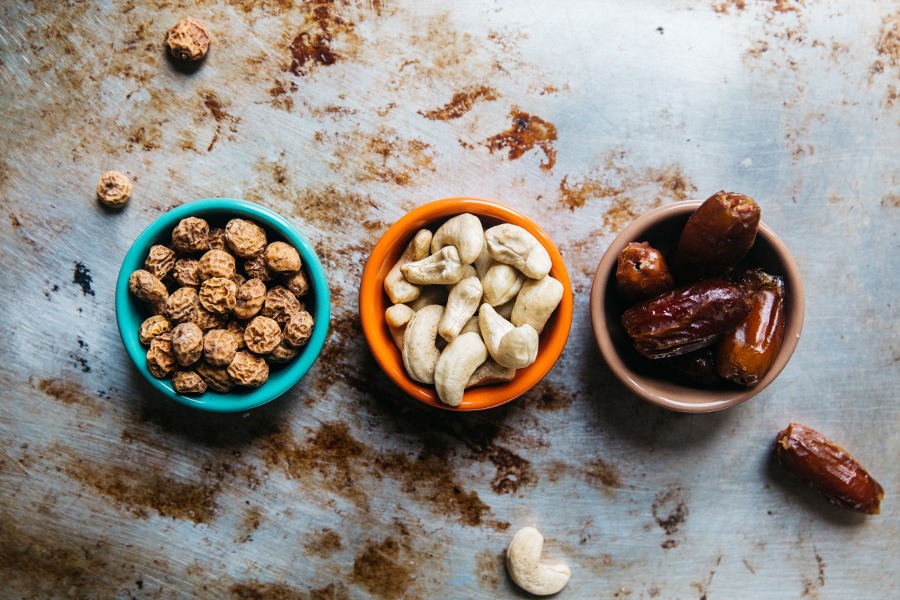A Guide To Eating Fats (And Which To Avoid)
Most of us grew up believing that eating foods high in fat was one of the worst things we could do to our bodies.

Bare Blends
2017-02-08


Most of us grew up believing that eating foods high in fat was one of the worst things we could do to our bodies.
There wasn’t much transparency around the types of fats that we were eating. Fat as a food group was associated with body fat, and there was a global fear around having a high-fat diet, because it was thought to lead to extreme obesity. But we won’t all die from obesity by eating fat, in fact, we’re much healthier when we’re eating good fats.
Having fats in our diets is necessary. Fat is a major source of energy, and it helps us absorb vitamins and minerals. Fat also plays an essential role in building cell membranes, and it is needed for blood clotting, muscle movement, and reduces inflammation, especially in the brain.
Good fats therefore provide cardiovascular protection, improve body composition, and are essential to brain health. Some other benefits include alleviating depression and anxiety, promoting healthy lung and organ function, and boosting metabolism.
If weight loss is your goal, then contrary to popular belief, we need to be eating fat. It will help to balance your hormones, which is integral to managing weight.
So what determines the type of fat?
Fats are organic molecules which are composed of carbon and hydrogen. These are joined together in chains, and different chain compositions determine what type of fat it is - monounsaturated, polyunsaturated, saturated, or trans fats. It also determines whether the fat is good or bad for us.
Good fats

Good fats are the fats that are essential to our diet. These are unsaturated fats such as monounsaturated fats and polyunsaturated fats. These are liquid at room temperature, such as in olive oil, avocados, nuts, seeds, etc, and when these fats replace saturated fats in a diet, they help to lower LDL cholesterol and raise HDL (the good cholesterol).
Good fats also contain omega-3 fatty acids, which are important as they fight inflammation, and lower blood pressure and triglycerides. The can even neutralise any negative effects made by too much omega-6 and bad fats. Omega-3s have also been shown to reduce inflammation and may help prevent chronic diseases, such as heart disease and arthritis.
There are three types of omega-3 fatty acids: ALA, DHA, and EPA. ALA (alpha-linolenic acid) is an essential part of our diet, because it can’t be produced by the human body. ALA is found in plants such as chia seeds and flaxseeds, and maintains healthy heart function. Although ALA is converted to EPA and DHA before it can be absorbed by the body, it’s important to get plant-based sources of omega-3 in your diet. EPA (eicosapentaenoic acid) and DHA (docosahexaenoic acid) are omega-3s that are found mainly in fish, and are integral to our heart, brain and eye development and function.
Bad fats

Bad fats are also known as trans fats. These are liquid oils bonded with hydrogen so they stay solid at room temperature. These are found in many processed foods and fried foods, and it’s best to steer clear of them altogether.
Another thing to avoid is fats that are too high in omega-6. Some research suggests that a diet high in omega-6, as opposed to omega-3, can lead to an increased risk of inflammatory and autoimmune diseases such as cardiovascular disease, cancer, type 2 diabetes, and more. Therefore, the amount of omega-6 should be reduced, and the amount of omega-3 should be increased where possible.
Saturated fats

Saturated fats are often wrongly accused of being bad for you. Saturated fat is not just a single fat, in fact there are more than 12 kinds of saturated fat, and all of them have different attributes.
It’s therefore difficult to generalise about saturated fats as a whole. Some of the types of saturated fats include: palmitic and myristic acids, stearic acid, and lauric acid, and there’s no evidence that any of these are particularly harmful. Lauric acid, for example, is found in coconut oil, which is not harmful, but rather provides us with benefits such as preventing heart disease and high blood pressure, and raising the HDL cholesterol (the good cholesterol) in the body.
But overconsumption of saturated fats should be avoided (like any macronutrient). Because we tend to eat a high amount of animal foods and oils, we tend to get too much saturated fats in our diets, and when we combine these with refined carbohydrates, our overall health can suffer.
In the case of saturated fats, a balance is needed. As everybody’s metabolism is different, and fat can be used as energy at different rates. People who exercise more can use fat as a readily available energy source, but fats wouldn’t be used for energy as much for a less active person with a slower metabolism, and therefore moderation is needed.
So how do we get more of the good fats in our diet, without eating salmon every day? Here are our two suggestions.
1. Whey Protein Concentrate
Bare Blends’ Whey Protein Concentrate contains extra nutrients from the good fats that are naturally occurring in whey protein. It comes from grass-fed cows in the pristine fields of New Zealand, and is naturally rich in immune-boosting immunoglobulins, amino acids and free radical neutralizing antioxidants that are found only in WPC.
WPC is perfect in smoothies and raw treats, and will boost your energy levels and nutrient intake from the good fats and protein.
2. Chia Seeds
Chia seeds are a superfood high in calcium, iron, vitamin C, manganese and phosphorous. Chia is also one of the richest plant-based sources of ALA omega-3 fatty acids. Although the ALA in Chia has to be converted into DHA and EPA before it can be absorbed by the body, consuming ALA along with other EPA, DHA sources like fish and grass fed meat is essential for a balanced diet. Plant-based sources of omega-3 have other benefits that fish and meat do not. Chia also provides dietary fibre, as well as help to control blood sugar levels, which is essential for managing weight and boosting energy levels.
Chia seeds contain all nine essential amino acids making them a complete protein source, and a vital component to the health of our muscles, cells and tissues.
The best way to get good fats in your diet is to eat a mix of whole, unprocessed, and high-quality foods.
Eat plenty of avocado, fish, nuts, seeds, olive oil, coconut, and cacao, and stay away from processed foods.
Don’t worry about the percentages or exact measurements, but rather keep it simple, and realise that there are many benefits, and really no downsides, to having good fats in your diet.
SOURCES OF FATS
Monounsaturated fats
- Red meat
- Whole milk products
- Olives
- Avocados
- Oils such as olive, peanut, canola, sunflower and sesame
- Nuts
Polyunsaturated fats
- Fish such as salmon, mackerel, herring, tuna, and trout
- Walnuts
- Sunflower seeds or sunflower oil
- Flaxseeds or flax oil
- Soybean oil
Omega-3
- Chia seeds
- Fish such as salmon and mackerel
- Flaxseed oil
- Walnuts
- Soybeans
- Spinach
Omega-6
- Poultry
- Eggs
- Nuts
- Whole-grain breads
- Vegetable oils
- Grape seed oil
Saturated fats
- Red meat
- Poultry
- Butter
- Cheese
- Coconut oil
- Nuts such as brazil nuts, cashews, pine nuts
Trans fats
- Processed foods
- Deep fried foods
- Margarine
- Store bought cookies and cakes
- Hydrogenated vegetable oil
- Etc.
SOURCES:
https://www.ncbi.nlm.nih.gov/pubmed/12480795
https://www.ncbi.nlm.nih.gov/pubmed/20329590
http://www.webmd.com/women/features/omega-3-fatty-acids#1
http://www.webmd.com/healthy-aging/omega-3-fatty-acids-fact-sheet
Products in this post

Organic Chia Seeds

